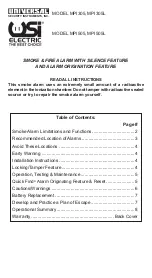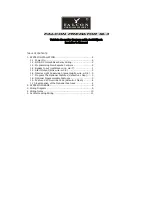
FCC PART 15 RADIO FREQUENCY DEVICES
This equipment has been tested and found to comply with the limits for a Class B digital device pursuant to part 15 of the
FCC Rules. These limits are designed to provide reasonable protection against harmful interference in a residential
installation. This equipment generates, uses and can radiate radio frequency energy and, if not installed and used in
accordance with the instructions, may cause harmful interference to radio communications, However, there is no guarantee
that interference will not occur in a particular installation. If this equipment does cause harmful interference to radio or
television reception, which can be determined by turning the equipment off and on, the user is encouraged to try to
correct the interference by one or more of the following measures:
-- Reorient or relocate the receiving antenna.
-- Increase the separation between the equipment and receiver.
-- Connect the equipment into an outlet on a circuit different from that to which the receiver is connected.
-- Consult the dealer or an experienced radio/TV technician for help.
CAUTION (AS REQUIRED BY THE CALIFORNIA STATE FIRE MARSHAL)
"Early warning fire detection is best achieved by the installation of fire detection equipment in all rooms and areas of the
household as follows. A smoke alarm installed in each separate sleeping area (in the vicinity of, but outside of the
bedrooms), and heat or smoke detectors in the living rooms, dining rooms, bedrooms, kitchens, hallways, attics, furnace
rooms, closets, utility and storage rooms, basements and attached garages.
Page 8
Blinks On once
approx every
40-45 seconds
DC Power is present.
3 Beeps,
2 second pause,
Repeat
Blinks On approx
every 2 seconds
3 Beeps,
2 second pause,
Repeat
Blinks On approx
every 2 seconds
Blinks On once
approx every
40-45 seconds
(normal operation
mode) or Blinks on
once approx every
10 seconds
(silence mode)
Originating smoke alarm - If hazard is identified, please take
all precautions if an alarm sounds by calling an Emergency
Service and getting out of the home.
OPERATIONAL SUMMARY
Silent
Blinks On once
approx every
40-45 seconds
Silent
1 Chirp every
40 seconds
Low Battery - Check to make sure the battery activation pull-
tab has been completely removed, battery polarity is correct
and the battery terminals are making contact with the smoke
alarm contacts in the battery drawer. If chirp continues,
replace the 9V battery (see User's Manual for recommended
battery types).
To Reset the Alarm - Hold the Test/Silence button for 10
seconds, or temporarily remove (and then replace) the battery.
This will clear alarm origination and clear Silence mode. Reset
after each smoke alarm
event.
QUICK FIND
®
Alarm Origination - To initiate
QUICK FIND
®
, press
the Test/Silence button on any alarm; and, after releasing the button,
the originating alarm will continue to sound for approx 60 seconds.
Reset the originating alarm.
Nuisance Alarm - If there is no hazard present, verify the
alarm is mounted in the correct location (see User's Manual,
"AVOID THESE LOCATIONS" section). Reset alarm as
instructed below.
3 Beeps,
2 second pause,
Repeat
Silence Feature is activated by pressing and releasing the
Test/Silence button on the initiating alarm while in alarm
condition. Silence mode will last for 8-12 minutes.
Blinks On approx
every 2 seconds
Silent
(alarmed
previously)
Blinks On once
approx every
40-45 seconds (normal
operation mode) or
Blinks On once approx
every 10 seconds
(silence mode)
CONDITION OF ALARM AUDIBLE & VISUAL SIGNALS BEFORE SOLUTION / RECOMMENDATION
SOLUTION / RECOMMENDATION
HORN
RED LED
Blinks On once
approx every
40-45 seconds
1 Beep
approx every
60 seconds
End-of-Service Life alarm. The alarm should be replaced
immediately.
Blinks On once
approx every
40-45 seconds
3 Beeps approx
every 40 seconds
after LED flashes
Trouble/Service Alarm. Replace Alarm.



























